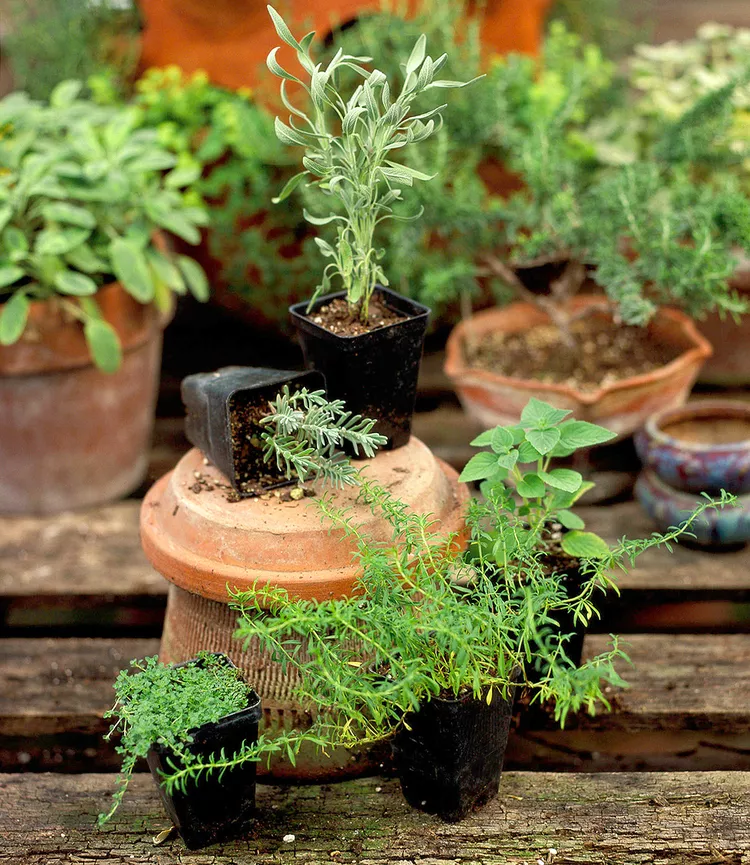How to Care for Herbs

Fresh herbs make just about any dish better, and for good reason. Not only do we love the fragrance and flavor they provide, but we love how easy they are to grow and maintain. Whether you're looking to plant thyme, oregano, chives, or mint—we've got you covered on the basics of herb care and what you should know before you start planting.
Starting Herb Seeds Indoors
Some herbs, such as basil, chives, parsley, and dill, grow easily from seed. Other varieties that are easy to start include angelica, borage, chamomile, chervil, cilantro, coriander, fennel, lemon balm, marjoram, sage, stevia, thyme, and winter savory.
If you start your herbs from seeds, follow the planting instructions on the packet. The basics are the same, whether you start the seeds indoors to get a jump on the growing season, or plant them directly in the ground.
When to Plant Herb Seeds Outdoors
The best time to plant an herb depends on its cold tolerance and the average last frost date in your area. Sow hardy perennial herb seeds outdoors several weeks before your average last frost date. However, most tender, annual herbs germinate better in warm soil—so wait until after the average last frost date to plant them.
Transplanting Herbs
Plant container-started herbs in the garden after the danger of frost has passed. Dig a hole at least twice as wide as, but no deeper than, the pot in which the herb has been growing. Slide the plant out of its nursery pot and loosen or slice through any circling roots, then place the root ball into the hole and just barely cover it with soil. Water the root zone well after planting.
Ready to grow more edibles? Check out our guide to vegetable gardening.
Watering
Most herbs grow best in well-drained soil and develop their most intense flavor if they're kept on the dry side. Their watering needs depend on soil type, weather conditions, and variety. For example, you'll need to water plants growing in sandy soils more frequently than those in clay. Keep in mind that plants use more water during hot, windy conditions with low humidity than in cool, humid, and cloudy conditions.
When watering, apply enough water to moisten the root zone at least 6 inches deep. Soaker hoses or drip irrigation systems are efficient ways to apply water: They avoid wasting water by applying it just to the root zone of the plants and prevent disease by keeping the foliage dry.
Fruit is a great home garden addition. Find out in our guide.
Feeding
Herbs that receive high levels of nutrients, particularly nitrogen, produce inferior growth with little flavor or fragrance. For that reason, avoid overfertilizing. Organic fertilizers, which decompose slowly, and controlled-release manufactured fertilizers are less likely to overfeed nutrients. Follow soil test recommendations or label directions to learn how much fertilizer to apply.
Test Garden Tip: Never use fresh manure in your herb garden. Compost it first to eliminate the possibility of spreading harmful bacteria onto your herbs.
Pinching
Tender new growth is the most flavorful and succulent part of herbs. Keep your plants lush and bushy by regularly pinching 2-3 inches off the stem tips. This encourages branching and new growth. If you desire more leaves, pinch off any flowers that form. Stop pinching or pruning woody herbs at least eight weeks before the first frost of fall to give the new growth time to harden off before winter.
Spring Pruning
If you haven't already cleaned them off in autumn, in spring prune the dead stems of last year's growth on plants such as lemon balm, mint, artemisia, and tansy. Some perennial herbs become woody or lanky after several years in the garden. In spring, prune them back by one-third or to within 4 inches of the ground before new growth begins. This encourages a bushy, more compact form.
Dividing Herbs
Some perennial herbs, such as chives, form clumps, while others ,such as thyme, spread by runners. You can dig up and divide both spreading and clumping types in early spring to make new plants.
Taking Cuttings
Propagate woody herbs, such as rosemary, from stem cuttings. Less woody herbs, such as thyme, mint, oregano, and basil, will also root easily from cuttings.
Layering Herbs
Stems of some herbs form roots where they come into contact with the ground. You can help the process along by layering the stems. Bend a flexible stem to the soil, nick the base of it, apply rooting hormone, pin it to the soil, keep moist, and wait several months for roots to form.
Mulching
Prevent weeds by using mulch. Organic mulches, such as wood chips, cocoa bean shells, or pine needles are good to use. Apply a layer of mulch two to four inches deep, but keep it away from the crown of the plant. Mulch smothers weeds, prevents most weed seeds from germinating, and those that do grow are easier to pull. In addition, mulch conserves moisture, so you'll need to water less frequently.